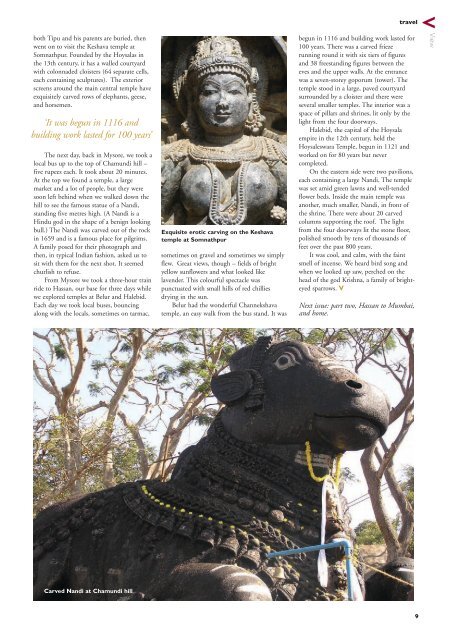Hampshire - View Magazines
Hampshire - View Magazines
Hampshire - View Magazines
Create successful ePaper yourself
Turn your PDF publications into a flip-book with our unique Google optimized e-Paper software.
oth Tipu and his parents are buried, then<br />
went on to visit the Keshava temple at<br />
Somnathpur. Founded by the Hoysalas in<br />
the 13th century, it has a walled courtyard<br />
with colonnaded cloisters (64 separate cells,<br />
each containing sculptures). The exterior<br />
screens around the main central temple have<br />
exquisitely carved rows of elephants, geese,<br />
and horsemen.<br />
‘It was begun in 1116 and<br />
building work lasted for 100 years’<br />
The next day, back in Mysore, we took a<br />
local bus up to the top of Chamundi hill –<br />
five rupees each. It took about 20 minutes.<br />
At the top we found a temple, a large<br />
market and a lot of people, but they were<br />
soon left behind when we walked down the<br />
hill to see the famous statue of a Nandi,<br />
standing five metres high. (A Nandi is a<br />
Hindu god in the shape of a benign looking<br />
bull.) The Nandi was carved out of the rock<br />
in 1659 and is a famous place for pilgrims.<br />
A family posed for their photograph and<br />
then, in typical Indian fashion, asked us to<br />
sit with them for the next shot. It seemed<br />
churlish to refuse.<br />
From Mysore we took a three-hour train<br />
ride to Hassan, our base for three days while<br />
we explored temples at Belur and Halebid.<br />
Each day we took local buses, bouncing<br />
along with the locals, sometimes on tarmac,<br />
Carved Nandi at Chamundi hill<br />
Exquisite erotic carving on the Keshava<br />
temple at Somnathpur<br />
sometimes on gravel and sometimes we simply<br />
flew. Great views, though – fields of bright<br />
yellow sunflowers and what looked like<br />
lavender. This colourful spectacle was<br />
punctuated with small hills of red chillies<br />
drying in the sun.<br />
Belur had the wonderful Channekshava<br />
temple, an easy walk from the bus stand. It was<br />
travel v<br />
begun in 1116 and building work lasted for<br />
100 years. There was a carved frieze<br />
running round it with six tiers of figures<br />
and 38 freestanding figures between the<br />
eves and the upper walls. At the entrance<br />
was a seven-storey goporum (tower). The<br />
temple stood in a large, paved courtyard<br />
surrounded by a cloister and there were<br />
several smaller temples. The interior was a<br />
space of pillars and shrines, lit only by the<br />
light from the four doorways.<br />
Halebid, the capital of the Hoysala<br />
empire in the 12th century, held the<br />
Hoysaleswara Temple, begun in 1121 and<br />
worked on for 80 years but never<br />
completed.<br />
On the eastern side were two pavilions,<br />
each containing a large Nandi. The temple<br />
was set amid green lawns and well-tended<br />
flower beds. Inside the main temple was<br />
another, much smaller, Nandi, in front of<br />
the shrine. There were about 20 carved<br />
columns supporting the roof. The light<br />
from the four doorways lit the stone floor,<br />
polished smooth by tens of thousands of<br />
feet over the past 800 years.<br />
It was cool, and calm, with the faint<br />
smell of incense. We heard bird song and<br />
when we looked up saw, perched on the<br />
head of the god Krishna, a family of brighteyed<br />
sparrows. V<br />
Next issue: part two, Hassan to Mumbai,<br />
and home.<br />
9<br />
<strong>View</strong>





